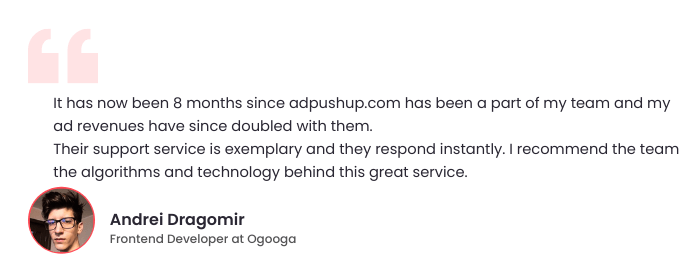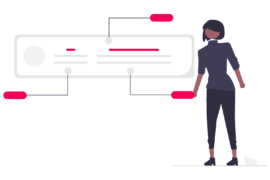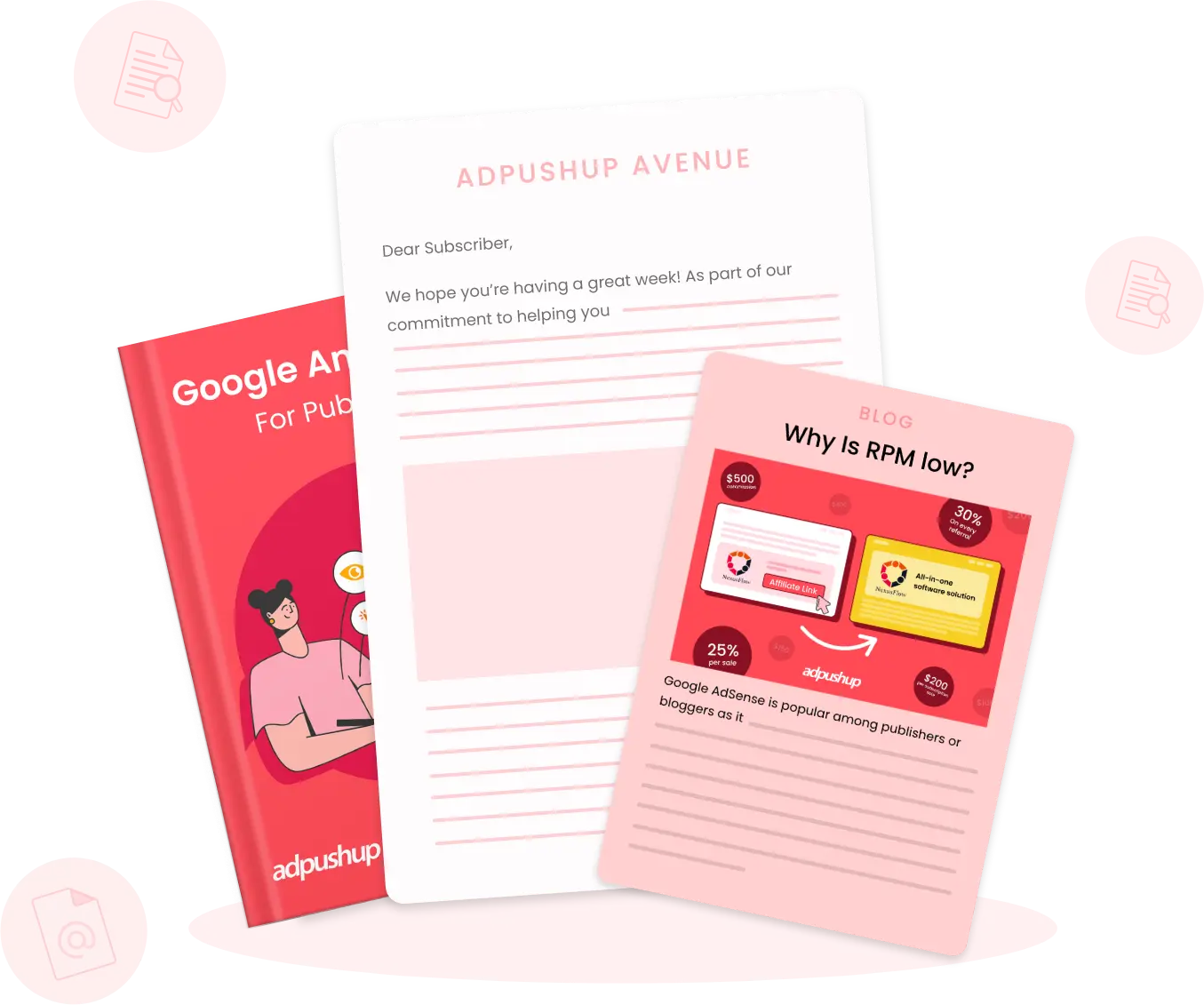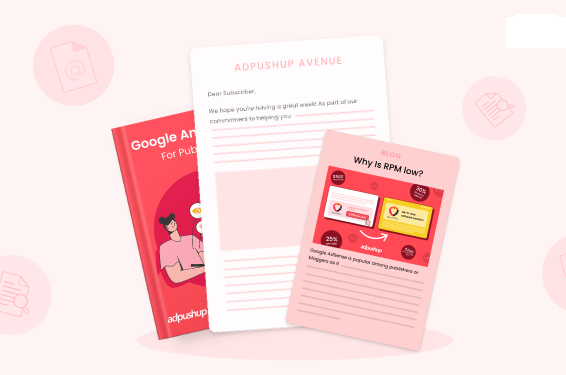Read our blog to know the top DSPs to consider in 2025 for effective targeting and advanced features to make programmatic advertising seamless for you.
We always talk about publisher-centric topics in our blogs. Be it supply-side platforms, metrics like eCPMs, or programmatic advertising trends relevant to publishers. We even discussed ways to improve ad revenue in one of our recent blogs.
But in this blog, we will be discussing top DSP, an essential advertiser-centric platform. DSPs are a programmatic platform that facilitates the buying of ad inventory via multiple platforms like ad networks and ad exchanges.
Let’s straightaway head to the list of top 10 DSP platforms.
10 Best Demand-side Platform Companies to Choose in 2025
1. Google DV360 DSP
DV360 is the gateway to Google’s walled garden for advertisers. And if you are new in the field, Google DV360 is your best bet as a beginner’s charm. To help you out, Google offers training sessions on its DSP.
The solution consists of five modules: audiences, creatives, inventory, campaigns, and insights.
Payment model: CPM
Ad formats: CTV ads, Display ads, Video ads, Audio ads
Features:
- Access to Google’s ad networks and third-party networks
- Effectively run cross-channel advertising campaigns across multiple platforms
- Offers robust anti-fraud measures and filters out fake impressions
- Access to numerous integrations like Youtube, Analytics 360, Google Cloud & third-party exchanges
2. Geniee DSP
Another one of the major DSPs in our list is the Geniee DSP. A popular DSP in the Asia-Pacific Region, it follows the mantra of reaching the right user at the right time to increase audience engagement.
Geniee is also touted as a top money-making DSP by many SEA (South-east Asia) publishers due to its intuitive layout and advanced ML-backed analysis.
Payment Model: CPM, CPV, CPC
Ad formats: Display ads, Native Ads, Social Media Ads, Instream ads, Outstream ads, Rich media ads
Features:
- Offers direct bidding on their SSP inventory to reduce intermediary margins, enabling more efficient reach compared to third-party networks
- Flexible brand or creative restrictions to allow for grey area campaigns (like alcohol or gambling)
- Offers customized rich media banners in various formats for an engaging user experience
At present, Geniee DSP is the only DSP is the market that offers CTR stabilization while increasing ad impressions to increase the overall ROI for advertisers. For example, if an advertiser asks us to maintain an X% CTR and at the same time optimize impressions – Yes, our DSP can do that.
— Boy Satria Sanusi, Associate Director Demand Business (Geniee Group)

3. StackAdapt DSP
Next in our list of demand-side platforms is StackAdapt DSP. It is North America’s fastest growing DSPs, having over 500+ publisher connections across 23 verticals. StackAdapat DSP is renowned for serving native ads in its most immaculate form.
It is an ideal choice for mid to large-sized ad agencies. However, the DSP doesn’t host HTML5 ads, which is why the advertisers may have to provide their own ad tags to serve these formats.
Ad formats: Display ads, Native Ads, Video Ads, Connected TV ads
Features:
- Offers “No fees, no contract” option to advertisers along with brand safety features
- Also offers geofencing, Ad-ID and MA-Id tracking, & in-app data for refined reporting
- Extensive targeting options like contextual targeting and retargeting
*Ad-ID: Advertising Digital Identifier, MA-Id: Mobile Advertising Digital Identifier
4. MediaMath DSP
One of the best DSPs in our list is MediaMath DSP. Now acquired by Infillion, it has been regarded as the first demand-side platform in the AdTech industry.
The DSP follows a sophisticated omnichannel approach while respecting user privacy. It does so by utilizing consent-based, cross-device identifiers along with identity graphs to engage users.
Moreover, MediaMath leads in innovation. It utilizes machine learning algorithms that continuously study user interactions and adjusts targeting parameters for precise targeting.
Payment Model: CPM
Ad formats: Display ads, Native Ads, Video Ads, Connected TV ads (Advanced TV ads), Audio ads, DOOH ads
Features:
- Works on unique first-party data from Infillion for unified targeting
- Has a large network of suppliers and works with 4000+ advertisers globally
- Specializes in delivering video ads to run impactful advertising campaigns
- Guarantees increased cost efficiency by 15% through MediaMath’s curated markets
5. Xandr DSP
Xandr Invest DSP by Microsoft Advertising, one of the top DSP companies, is known for reaching unique audiences via UID (unique identifiers). But what exactly enables it? Their advanced programmatic splits feature.
It lets you break a campaign into smaller parts and treat each one differently. For example, showing one ad more to certain people while showing another to others. This makes your ads more flexible and effective, without losing reach.
Payment Model: CPM
Ad formats: Banner ads, Native Ads, Video Ads (Instream+Outstream), Audio ads
Features:
- It is one of the top video DSPs specializing in Video and CTV ad inventory
- Access to various supply types like open exchanges, private marketplaces or curated deals
- It comes with an Array of targeting options with 2500+ audience segments
- Fraud prevention measures through thorough traffic monitoring
6. Amazon DSP
Amazon has built one of the largest DSPs in the entire industry. An offering of the Amazon Advertising Cloud, it is available to both sellers and non-sellers. Amazon uses its rich consumer database to offer minute-level market insights, robust targeting options, and cross-device targeting.
It also provides retailer-specific metrics that can help you deep-dive into the consumer behaviour and shopping patterns, making it ideal for e-commerce platforms.
Amazon DSP also offers CPI (cost-per-install) campaigns, making it one of the top mobile DSPs.
Payment Model: CPM
Ad formats: Responsive display ads, Custom Ads, Video Ads (Instream, Outstream, Streaming TV, Online Video), Audio ads, Display ads, Dynamic ads
Features:
- Access to other Amazon-owned platforms like Audible and Zappos
- Full-funnel tracking; from ad impression to purchase
- In-house A/B testing capabilities to make data-driven decisions
7. Centro (Basis) DSP
Centro DSP, now Basis, is one of the best demand-side platforms that works on omnichannel campaign strategy. What makes it stand out is its ability to integrate all advertising types (search, programmatic, social, site direct, CTV) via one single API.
Basis guarantees an increased productivity by 30% by reducing time, stages, and errors throughout the campaign process.
Payment Model: CPM, CPC, CPA
Ad formats: Text Ads, Display Ads, Video ads, Native ads, Rich-media ads, Playable ads, Interactive ads, Banner ads, Social Media ads
Features:
- Utilizes SmartBid AI to adjust bids and improve performance metrics like CTR, conversions, or impressions
- Cross-channel planning through RTB (real-time bidding), programmatic deals, and active private deals
- Streamlined and real-time reporting for optimal campaign optimization
8. Quantcast DSP
Quantcast is a DSP advertising software that utilizes advanced AI learning to understand and analyze online behavior. It uses this data to provide campaign optimization options in real-time, creating a strategic edge for the advertisers.
One of the top demand-side platforms in the market, it relies on an extensive bank of first-party data which makes it possible for the programmatic DSP to function even in cookieless environments.
Payment Model: CPM
Ad formats: Banner display ads, Rich media ads, Mobile ads, Native ads, Social media ads, Connected TV ads
Features:
- Designed to locate new and existing audiences in hard-to-reach environments
- Focuses on performance across the funnel to bring out the true value of the brand
- Intuitive dashboard that provides practical insights for data-driven decision making
9. OneView DSP
OneView DSP by Roku is a (Connected TV) CTV DSP that is preferred by advertisers who are specifically targeting the streaming audience. Its potential to reach 155+ million streaming users makes it one of the most popular DSPs for connected TV.
OneView grants an advertiser access to the Roku Channel (streaming on Roku platform), and other OTT apps on Roku Audience Network. With the wealth of user data, Roku utilizes AI machine learning for creating nuanced segments for robust targeting.
Payment Model: CPM
Ad formats: CTV ads, Interstitial ads, Interscroller ads, Adhesion ads, Outstream video ads, Marquee ads, Channel ads, Standard video ads
Features:
- Cross-screen engagement for a wider reach
- Doesn’t rely on cookies, IP addresses or consortiums, making the consumer-platform relationship highly stable
- All assets go through a thorough verification process to ensure brand safety
10. Criteo DSP
Criteo DSP, called Commerce Max, is a renowned advertising demand-side platform that’s famed for its extensive retargeting capabilities. Serving over 1.2 billion ads annually, the platform employs advanced machine learning for cross-device targeting and omnichannel reach.
The DSP utilizes Critero’s predictive AI to analyze offline and online first-party data to engage users and drive them to conversion. It also offers transparent real-time metrics like product-level sales data, interactions, reach, and view metrics.
Payment Model: CPM, CPC
Ad formats: Banner ads, Native ads, Rich media ads, Catalog ads, Recommendation ads, Video ads, Dynamic ads, HTML5 ads, Display ads, CTV ads
Features:
- Access to premium publishers via Commerce Marketing Ecosystem for both real-time bidding (RTB) and non-RTB deals
- On-demand report generation based on chosen criteria
- Highly suitable for retail marketers seeking sales and enhanced business outcomes
Another worthy mention in our list of DSP companies is Adobe DSP.
11. Adobe Advertising DSP
Adobe DSP offers end-to-end solutions with its all-in-one integrations and additional tools like Adobe Sensei. It supports cross-screen targeting to reach a wider audience for an impactful ad performance.
With its framework based on sophisticated ML, Adobe advertising DSP is designed to uplift your ad campaigns.
Payment Model: CPM
Ad formats: Native ads, Display ad, Video ads, Audio ads, CTV ads, DOOH ads
Features:
- Access to real-time in-dash reporting, raw activity logs, bespoke reports, and reporting APIs to create hyper-personalized campaigns
- Anti-fraud measures to identify fraudulent inventory secure brand safety
- In-house A/B testing to test creatives, ad frequency, ad placement, audiences, etc.
How to Choose the Right Demand Side Platform?
Consider the following factors when choosing the best DSP for your business:
Data
Can the DSP work in a cookieless environment? This is the first question you should be asking. With the rise in user privacy, many are turning to privacy-first platforms to comply with data privacy provisions. Many DSPs offer third-party integrations, but robust first-party integration is something you should look into.
Reach
Analyze your target audience’s demographics, behavioral patterns, and other parameters. Then, look for a DSP that caters to your parameters. For example, almost all DSPs cover the North American and European countries. However, only a handful cater to Asian (Geniee DSP being one) and Middle Eastern countries.
Is your audience more on mobiles/desktops or CTV? For example, OneView DSP by Roku is a dedicated CTV DSP to reach the streaming audience. Consider this factor as well when looking for the the best DSP.
Unified Integrations
As an advertiser, you shouldn’t have to use multiple platforms or get endless integrations to run a single campaign. Look for a DSP that offers access to various reports, inventory, and targeting options on a single platform. Also, consider a DSP that provides access to walled gardens for unified targeting.
Transparency
The biggest turnoff for an advertiser is the hidden fees that many DSPs levy. These include miscellaneous costs, pricing, commissions, or other fees. It’s advisable to cross-check before finalizing one.
Top DSPs: Key Takeaways
1. Top DSPs for 2025: They include Geniee, Google DV360, Quantcast, StackAdapt, Adobe, MediaMath and Criteo, among others.
2. Ease in Buying: DSPs streamline the process of buying ad inventory by selecting the ad space based on pre-determined criteria set by the advertiser.
3. Advanced features: These DSPs offer sophisticated advertiser-centric features like geofencing, cross-device targeting, brand safety measures, and cost efficiency.
4. Cookieless Working: Many DSPs mentioned in our list strictly comply with GDPR and CCPA and work on first-party data. This makes it easy for them to function in a cookieless environment, making them privacy-first platforms.
5. Ad Formats: The top DSPs mentioned in our list are known to offer a variety of ad formats to advertisers to engage their audience in the best possible manner. Many offer their own custom formats as well.
Frequently Asked Questions
Google DV360, The Trade Desk, and Criteo are the biggest DSPs. However, Geniee is a popular programmatic DSP platform in the APAC market.
Some examples of DSP include Adobe Advertising DSP, Amazon DSP, and Centro DSP among others.
Yes, Google Ads serves as a Demand Side Platform (DSP). But, unlike other DSPs, there is one significant difference. While other DSPs allow you to acquire traffic from other vendors, Google sells only from its own inventory.
The top DSPs by market share are StackAdapt (35.63%), Adform (23.45%), and Rubicon Project (MediaMath) (18.12%).









